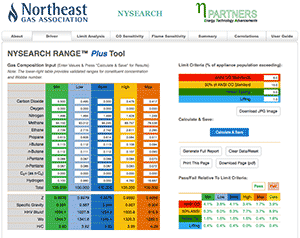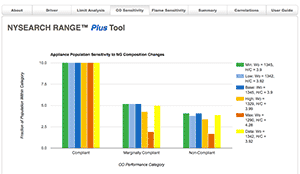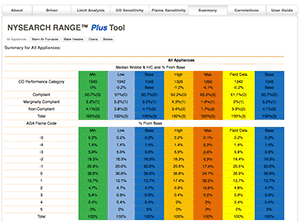NYSEARCH Range™ Plus Interchangeability Model
(Range of Acceptability for Natural Gas Equipment)
Description: Growth in shale and bio-derived gas supplies is broadening the range of natural gas compositions being distributed in North America. Furthermore, blending of hydrogen with natural gas may emerge as a strategy for optimizing the use of renewable energy. Such changes in gas composition can impact the performance of residential appliances. As noted by the National Gas Council’s Interchangeability Work Group in 2005, additional data is needed to characterize the impact of changing gas supplies on appliances. Over the last several years, NYSEARCH completed studies that fill information gaps regarding natural gas and renewable gas interchangeability for in-service residential appliances resulting in the development of NYSEARCH RANGE™ Plus spreadsheet-based interchangeability assessment model. It projects the performance of in-service residential appliance populations when new gas supplies are introduced.
Status: This tool is now available online to the project sponsors (who already have access) and to companies who can purchase an online subscription to this solution.
Cost: The cost for a one-year subscription to this online tool is $7500.
More Information:
NYSEARCH completed a comprehensive, geographically diverse study that determines the impacts of varying gas compositions including Renewable natural gas on performance of installed residential appliances. This data is now available in an easy-to-use online tool. Gas composition data is input and results are generated for each data set; the range of acceptable gas supplies for a service area or region can be determined. The NYSEARCH RANGE™ tool projects the performance characteristics for appliance populations by comparing the projections to safety- and operability-based performance limits. The output consists of histograms for appliance CO emissions and AGA flame code.
The NYSEARCH RANGE™ Plus model allows specification of a baseline gas composition (e.g., corresponding to historical deliveries or an adjustment gas) and up to four other gas compositions (e.g., new or proposed deliveries). For each gas composition specified, the performance of the appliance population is determined by applying project-derived correlations to each individual appliance in the database. Then histograms for CO emissions and AGA flame code are produced for each gas composition. A range of acceptability graph of Wobbe vs H/C ratio is developed based on set limits for the percentage of appliances in each of the performance categories (CO emissions, yellow tipping and lifting). These limits can be modified based on user company policy, regulation, historical practice or other acceptability criteria. An in-service appliance database was assembled by merging field performance data collected in this project with other data previously collected by a sponsoring LDC. The resulting dataset includes performance characteristics (gas flow rate; flue gas O2, CO, and NOx concentrations; gas manifold pressure; and flame characteristics) for about 3100 residential appliances.
The bioderived RNG tests provided data was used to update the existing carbon monoxide emission and flame characteristic (i.e., AGA Flame Code) correlations. The new correlations proved to be quite effective in predicting the response of a wide range of appliance and burner configurations to operation on RNGs. Hydrogen-natural gas blend test data previously collected by funding utilities was used to improve the model’s predictions for Power-to-Gas RNG. Hydrogen-air mixtures support flame speeds that are significantly higher than those for mixtures of air with the main constituents of natural gas (i.e., methane, ethane, propane, butane).
Ordering & Info
or call the NYSEARCH office:
(973) 265-1900.
Screen Shots



